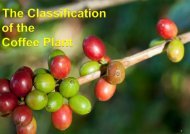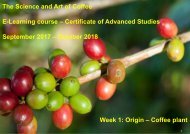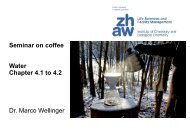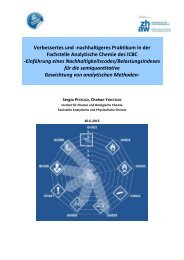Create successful ePaper yourself
Turn your PDF publications into a flip-book with our unique Google optimized e-Paper software.
C<strong>of</strong>fea canephora it characterised by its great variation in forms or ecotypes, and <strong>the</strong>refore it is much more<br />
difficult to distinguish varieties. This is due to its allogamous (cross-fertilizing) reproduction, where always<br />
pollen from ano<strong>the</strong>r tree is needed for fertilization. In contrast to self-fertilizing C. arabica, Robusta always<br />
mixes DNA from a multitude <strong>of</strong> individuals, which generated many different genotypes.<br />
Robusta c<strong>of</strong>fee is also more bitter and has less favourable organoleptic qualities, which is also mirrored in<br />
<strong>the</strong> trade prices, where Robusta is sold at 60 % lower prices than Arabica. However, quality <strong>of</strong> Robusta can<br />
still be improved with higher post-processing efforts. Yet, quality is sufficient for soluble c<strong>of</strong>fee production<br />
and to be used in blends with Arabica. There was also a larger demand for cheap c<strong>of</strong>fee after <strong>the</strong> second<br />
world war, which boosted <strong>the</strong> share on world c<strong>of</strong>fee production for Robustas from 0 % in 1920 to 40 %<br />
today.<br />
For selection <strong>of</strong> Robusta trees, a strategy is frequently applied, where genotypes with a good general<br />
combining ability are selected. Doing that, one looks for individuals with a certain genotype that produce<br />
hybrids <strong>of</strong> good quality with many different o<strong>the</strong>r genotypes. This way one can higher <strong>the</strong> probability that<br />
<strong>the</strong> trees in <strong>the</strong> <strong>plant</strong>ation produce an evenly good quality crop.<br />
On <strong>the</strong> picture <strong>the</strong> geographic origins <strong>of</strong> <strong>the</strong> two main genetic groups <strong>of</strong> C. canephora are shown. The red<br />
area marks <strong>the</strong> Guinean group <strong>of</strong> Robustas (Ivory coast and Guinea), whereas <strong>the</strong> green area marks <strong>the</strong><br />
Congolese group with few sub-groups, e.g. C (Cameroon, <strong>the</strong> Central African Republic and Congo).<br />
Several geographic C. canephora varieties have been defined, e.g. Robusta in <strong>the</strong> Congo (around 1890<br />
Gaillan collected seeds to start a nursery, now Robusta is commonly used for <strong>the</strong> whole species), Nganda<br />
in Uganda and Kouilou from Central Africa. The latter species is now widely grown in Brazil, named<br />
Conilon.<br />
53








